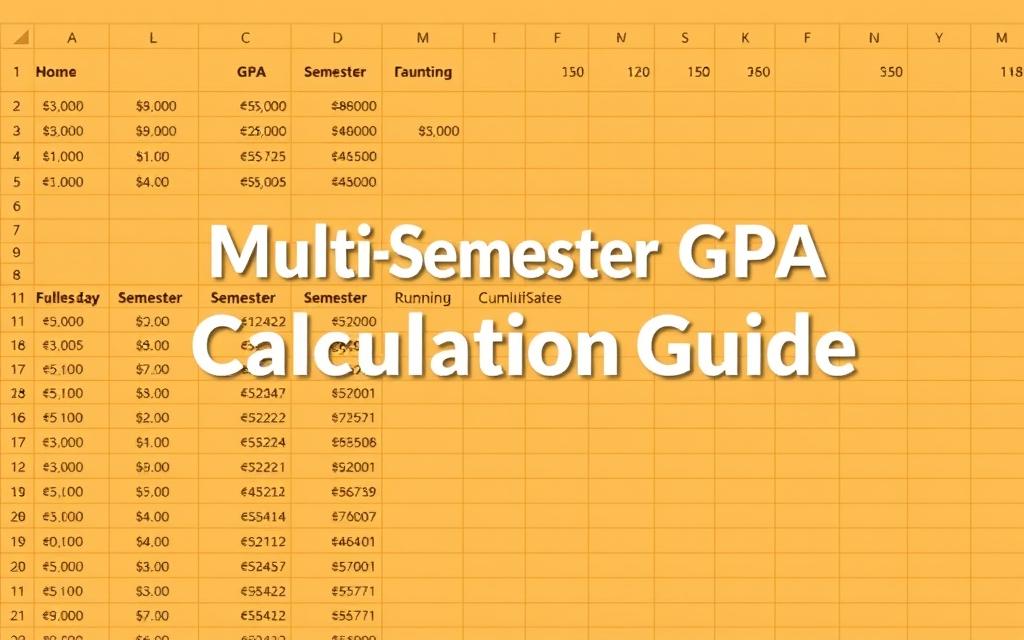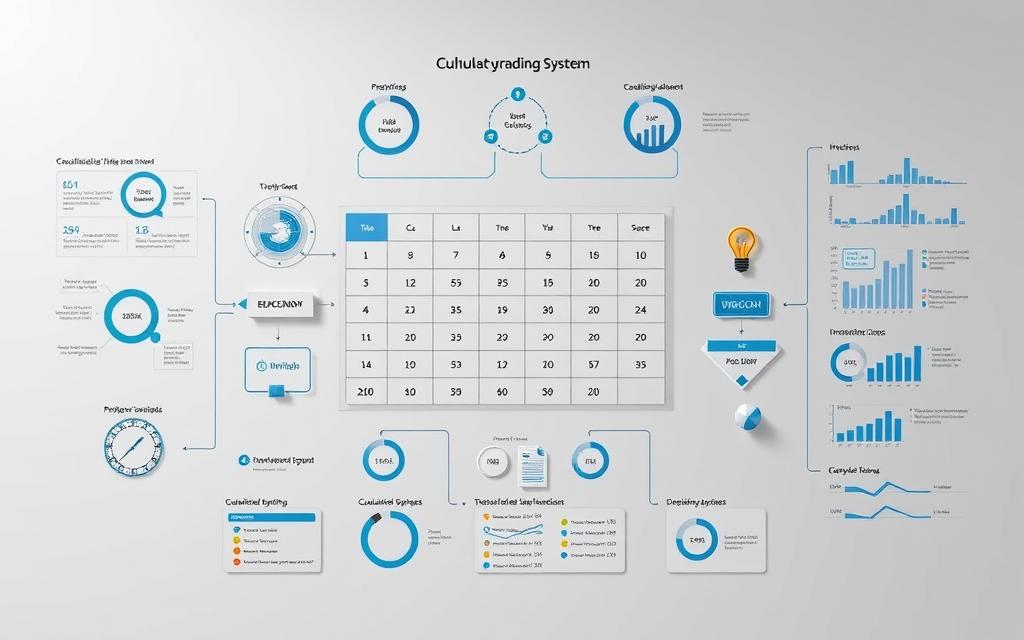A cumulative grading system is key for tracking academic performance. It shows overall achievement across multiple semesters or terms. This metric helps evaluate academic progress for students, educators, and institutions.
Colleges, scholarships, and employers often use cumulative GPAs to assess students. A high GPA can unlock exciting educational and career opportunities. It’s a vital measure of academic potential.
Calculating GPA requires precision and knowledge. Students must convert letter grades to numbers and multiply by credit hours. This process helps determine their total academic standing.
This guide simplifies GPA calculations into easy steps. By mastering these methods, students can control their academic story. They can also plan their educational journey more effectively.
Understanding Cumulative GPA Basics
Cumulative GPA is a key metric for tracking academic success. It measures a student’s overall achievement across multiple semesters. This provides a complete view of educational performance.
What Comprises a Cumulative GPA
Cumulative GPA is the average of all grades earned throughout a student’s academic career. It includes individual course grades and total credit hours completed. It also factors in performance across multiple academic terms.
- Individual course grades
- Total credit hours completed
- Performance across multiple academic terms
Semester vs Cumulative GPA: Key Differences
Semester and cumulative GPAs serve different purposes in academic tracking. Semester GPA shows performance in a single term. Cumulative GPA represents the entire academic record.
| Metric | Semester GPA | Cumulative GPA |
|---|---|---|
| Time Frame | Single Academic Term | Entire Academic Career |
| Calculation Scope | Current Semester Grades | All Completed Courses |
The Standard 4.0 GPA Scale Explained
The 4.0 GPA scale is a standard method for evaluating academic performance. On this scale, 4.0 represents an A grade. Lower points match up with lower letter grades.
- 4.0 represents an A grade
- Lower points correlate with progressively lower letter grades
- 0.0 indicates failing performance
This scale helps students understand their academic standing. It can also reveal opportunities for scholarships or advanced programs.
Essential Components of Grade Point Calculation
Grade point calculation relies on key elements that measure your academic performance. Credit hours are crucial. They show the weight and complexity of each course in your studies.
Grade point calculation goes beyond just letter grades. Each course has specific credit hours. These hours affect how much a course impacts your overall GPA. Courses with more credit hours have a bigger influence.
- Core courses typically carry 3-4 credit hours
- Elective courses usually range from 1-3 credit hours
- Laboratory or specialized courses may have additional credit weight
Schools may use different methods for course weight. Some use a weighted GPA system. This system gives higher points to advanced courses. Students can earn more than the standard 4.0 points.
| Course Type | Credit Hours | Point Multiplier |
|---|---|---|
| Regular Course | 3 | 1.0 |
| Honors Course | 3 | 1.1 |
| Advanced Placement | 3 | 1.2 |
Accurate grade and credit hour records are vital for precise GPA calculation. Students should track their performance closely. This helps them understand how each course affects their overall GPA.
How to Compute Cumulative Grading System
Calculating your cumulative GPA involves several precise steps. These steps turn letter grades into a comprehensive academic performance metric. Understanding this process helps students track their progress accurately.
Letter grade conversion changes alphabetic grades into numerical grade points. Each letter grade has a specific point value on the standard 4.0 scale.
Converting Letter Grades to Grade Points
Quality points calculation starts with understanding grade point values:
- A = 4.0 points
- B = 3.0 points
- C = 2.0 points
- D = 1.0 points
- F = 0.0 points
Multiplying Credits by Grade Points
To find quality points for each course, multiply grade point value by credit hours. This step turns letter grades into meaningful academic measurements.
| Course | Grade | Credits | Grade Points | Quality Points |
|---|---|---|---|---|
| Mathematics | A | 3 | 4.0 | 12.0 |
| English | B | 4 | 3.0 | 12.0 |
Calculating Total Quality Points
The final cumulative GPA is found by dividing total quality points by total credit hours. For example, 32.6 quality points across 9 credit hours would result in a 3.62 GPA.
Pro Tip: Always double-check your calculations to ensure academic record accuracy.
Managing Multiple Semester Calculations
Calculating GPAs across multiple semesters can be tricky for students. It’s important to know how to combine different term GPAs and handle transfer credits. This ensures an accurate picture of your academic performance.

Combining Different Term GPAs
To calculate a cumulative GPA, you need to combine grades from each term. First, calculate individual semester GPAs. Then, determine total quality points for each term.
Next, sum up all credit hours completed. Finally, divide total quality points by total credit hours.
- Calculating individual semester GPAs
- Determining total quality points for each term
- Summing total credit hours completed
- Dividing total quality points by total credit hours
Handling Transfer Credit GPA
Transfer credits need special attention during GPA calculations. Key considerations include:
- Verifying credit equivalency between institutions
- Converting grades from different grading scales
- Confirming which transfer credits count toward the cumulative GPA
Quarter vs Semester Hour Conversions
Converting between quarter and semester systems requires careful math. The standard method involves dividing quarter credits by 1.5 to get semester credits. To get quarter credits, multiply semester credits by 1.5.
Don’t forget to adjust quality points during conversion. This ensures everything matches up correctly.
- Dividing quarter credits by 1.5 to determine semester credits
- Multiplying semester credits by 1.5 to calculate quarter credits
- Proportionally adjusting quality points during conversion
Accurate credit conversion ensures seamless academic record maintenance across different educational systems.
Advanced GPA Calculations for Different Academic Systems
Understanding worldwide grading systems is key to international GPA conversion. This process can be tricky for students and academic professionals. Translating academic credentials across national frameworks often presents challenges.
GPA equivalencies in international systems are complex. Many countries use grading methods that differ from the U.S. 4.0 scale. These include percentage-based systems, 10-point scales, and pass/fail methods.
- Percentage-based systems
- 10-point grading scales
- Pass/fail evaluation methods
- Narrative assessment frameworks
Special conversion strategies are needed for non-traditional grading systems. Chinese and Indian academic records often require unique translation techniques. These methods help accurately show a student’s performance.
| Country | Native Scale | US Equivalent |
|---|---|---|
| France | 20-point scale | 4.0 GPA |
| India | Percentage system | 4.0 GPA |
| China | 100-point scale | 4.0 GPA |
Converting international GPAs involves several key steps:
- Identify the original grading system
- Determine standardized conversion metrics
- Apply appropriate mathematical transformations
- Validate converted academic credentials
Precision in international GPA conversion ensures accurate representation of academic achievements across global educational landscapes.
Weighted vs Unweighted GPA Computation
GPA calculation can greatly affect a student’s academic profile. Weighted GPAs offer a fuller view of performance. They recognize the challenges of advanced coursework.
Unweighted GPAs use a standard 4.0 scale. Weighted GPAs give extra points for harder classes. This system shows which students take on more difficult courses.
Understanding Course Difficulty Multipliers
Course difficulty multipliers highlight academic rigor. The weighted GPA system adds extra points for advanced courses:
- Regular courses: 0.0 point boost
- Honors courses: 0.5 point boost
- Advanced Placement (AP) courses: 1.0 point boost
- International Baccalaureate (IB) courses: Varies by level
Advanced Placement and Honors Course Calculations
AP course GPA calculations need careful thought. Honors class GPA boosts can improve a student’s standing. They show the extra work put into harder classes.
International Baccalaureate Grade Conversions
IB grade conversion involves several steps. Standard and Higher Level IB courses get different point adjustments. This affects the final weighted GPA calculation.
Pro tip: Always check with your specific school district for exact weighted GPA computation methods.
Weighted GPAs aim to show student achievements more clearly. They recognize the extra effort needed in advanced courses. This system gives a fuller picture of academic performance.
Common Calculation Mistakes to Avoid
GPA calculations can be tricky. Small errors can greatly impact your academic record. Understanding common mistakes helps students maintain accuracy and avoid pitfalls.
Students often face several critical GPA accuracy issues. These can lead to miscalculations if not addressed properly.
- Forgetting to account for plus/minus grades in point calculations
- Incorrectly weighing course difficulty levels
- Miscalculating credit hours for different course types
- Failing to convert grades between different academic systems
Grade point pitfalls occur when students miss calculation details. An unweighted GPA can differ greatly from a weighted one. This is especially true for advanced placement or honors courses.
To prevent GPA calculation errors, try these key strategies:
- Double-checking all mathematical computations
- Using reliable digital GPA calculators
- Confirming credit hour assignments
- Verifying grade point conversions
Accurate GPA tracking needs careful attention to detail. Always compare your calculations with official academic records. This ensures your GPA is completely accurate.
Conclusion
GPA is more than just a number. It’s a crucial skill for students in higher education. Calculating cumulative GPA requires precision and impacts college admissions evaluations.
Strategic GPA management goes beyond calculations. Students should see their grade point average as a full academic picture. Top schools like Harvard closely examine these metrics.
The Academic Index (AI) shows how deeply colleges analyze performance. It combines GPA and test scores to quickly assess academic potential. However, GPA is just one part of a student’s educational journey.
Mastering GPA calculation helps students track progress and set goals. It also helps them understand their performance in broader contexts. Regular monitoring can turn these numbers into tools for growth.




